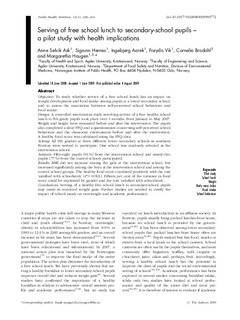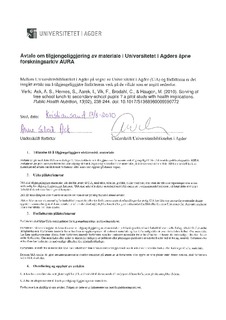| dc.contributor.author | Ask, Anne Selvik | |
| dc.contributor.author | Hernes, Sigrunn | |
| dc.contributor.author | Aarek, Ingebjørg | |
| dc.contributor.author | Vik, Frøydis N. | |
| dc.contributor.author | Brodahl, Cornelia | |
| dc.contributor.author | Haugen, Margaretha | |
| dc.date.accessioned | 2010-08-16T14:09:32Z | |
| dc.date.available | 2010-08-16T14:09:32Z | |
| dc.date.issued | 2010 | |
| dc.identifier.citation | Ask, A. S., Hernes, S., Aarek, I., Vik, F., Brodahl, C., & Haugen, M. (2010). Serving of free school lunch to secondary-school pupils - a pilot study with health implications. Public Health Nutrition, 13(02), 238-244. doi: 10.1017/S1368980009990772 | en_US |
| dc.identifier.issn | 1368-9800 | |
| dc.identifier.uri | http://hdl.handle.net/11250/138982 | |
| dc.description | Published version of an article from the journal Public Health Nutrition, Copyright Cambridge University Press. Article also available from publisher: http://dx.doi.org/10.1017/S1368980009990772 | en_US |
| dc.description.abstract | Objective: To study whether service of a free school lunch has an impact on
weight development and food intake among pupils at a lower secondary school,
and to assess the association between self-perceived school behaviour and
food intake.
Design: A controlled intervention study involving service of a free healthy school
lunch to 9th grade pupils took place over 4 months, from January to May 2007.
Weight and height were measured before and after the intervention. The pupils
also completed a short FFQ and a questionnaire concerning self-perceived school
behaviour and the classroom environment before and after the intervention.
A healthy food score was calculated using the FFQ data.
Setting: All 9th graders at three different lower secondary schools in southern
Norway were invited to participate. One school was randomly selected as the
intervention school.
Subjects: Fifty-eight pupils (91 %) from the intervention school and ninety-two
pupils (77 %) from the control schools participated.
Results: BMI did not increase among the girls at the intervention school, but
increased significantly among the boys at the intervention school and among the
control school groups. The healthy food score correlated positively with the trait
‘satisfied with schoolwork’ (P,0?001). Fifteen per cent of the variance in food
score could be explained by gender and the trait ‘satisfied with schoolwork’.
Conclusions: Serving of a healthy free school lunch to secondary-school pupils
may result in restricted weight gain. Further studies are needed to clarify the
impact of school meals on overweight and academic performance. | en_US |
| dc.language.iso | eng | en_US |
| dc.publisher | Cambridge Journals | en_US |
| dc.title | Serving of free school lunch to secondary-school pupils - a pilot study with health implications | en_US |
| dc.type | Journal article | en_US |
| dc.type | Peer reviewed | |
| dc.subject.nsi | VDP::Medical disciplines: 700::Health sciences: 800::Nutrition: 811 | en_US |
| dc.subject.nsi | VDP::Medical disciplines: 700::Health sciences: 800::Community medicine, Social medicine: 801 | en_US |
| dc.source.pagenumber | 238-244 | en_US |

